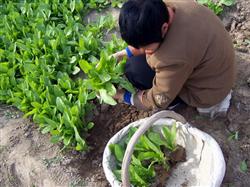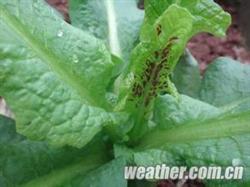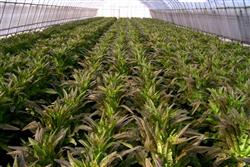Efficient multiple cropping of winter lettuce and early spring pepper in greenhouse

The multiple cropping of winter lettuce and early spring pepper in greenhouse can obviously improve the utilization rate of greenhouse and increase the cultivation yield and economic benefit. 1. Cultivation of winter lettuce 1. Optimized varieties: the variety of lettuce with disease resistance, high yield and cold tolerance was selected. 2. Carefully raising seedlings: sowing and raising seedlings in a small arch shed from late August to late September. After sowing, the greenhouse film should be ventilated and covered with sunshade net to reduce the temperature during the day, and the greenhouse film should be covered when it rains at night. From seedling division to slow seedling stage, shade is needed during the day to create an environmental temperature suitable for the growth of lettuce. Try to control watering, no drought, no watering, in order to prevent seedlings from overgrowing. The seedlings were planted in the greenhouse at the age of 35 days. 3. Fertilizer and water requirements: 5000 kg of mature organic fertilizer and 50 kg of ternary compound fertilizer are applied per mu, land preparation is made, row spacing is 50 cm, plant spacing is 35 cm, and about 3500 plants are planted per mu. Water immediately after planting. In the slow seedling stage, the greenhouse temperature was ventilated when the temperature was more than 20 ℃, and the temperature in the greenhouse was not more than 25 ℃ during the day and 3-10 ℃ at night. After the temperature dropped, grass curtain was added to keep warm before and after the Beginning of Winter, and double film and double mulch were adopted when the temperature was low. In fertilizer management, the method of light application of seedling fertilizer and heavy application of opening fertilizer was adopted. 4. Disease control: focus on the prevention and control of downy mildew, Sclerotinia sclerotiorum, soft rot and other diseases. Control downy mildew with 64% poisonous alum, 1000 times of sclerotiorum and 1300 times of neophytomycin or 72% agricultural streptomycin to control soft rot. 5. Timely harvest: lettuce harvest should be carried out when it is not old or young. Too young and too old will affect the value of goods. In general, it is appropriate to master the edible rate of meat parts to more than 90%. 2. Cultivation of early spring pepper 1. Optimized varieties: Haifeng 68 with high yield and disease resistance was selected. 2. Carefully raising seedlings: sowing and raising seedlings in the greenhouse from late October to early November. During the period of seedling raising, double film mulching and double layer grass mulch were adopted to keep warm. The seedlings were divided into 3 leaves and 1 heart stage, and were planted when buds appeared, and the seedling age was about 100 days. 3. Planting management: timely soil preparation, fertilization and bedding after lettuce harvest. In the first and middle of February, when the temperature in the greenhouse was stable at 10-12 ℃, the row spacing was 60 cm, the plant spacing was 35 cm, and 3000 plants were planted per mu. Watering slow seedling water once after planting, and ploughing for 2-3 times, and squatting seedlings after slow seedling. After sitting, apply 7.5 kg of urea and 4-6 kg of potassium sulfate per mu combined with watering; irrigate small water every 7-10 days and fertilize once every other time, 5-10 kg of urea and 8-10 kg of potassium sulfate per mu; 15-20 kg of diammonium phosphate during harvest period. During the slow seedling stage, the temperature was kept at 28-32 ℃ in daytime and 18-20 ℃ at night, and 25-30 ℃ in daytime and 18-20 ℃ at night in the result period. During the plant growth period, the relative humidity was adjusted to 50-70% by controlling watering and venting. Remove the side branches and old leaves below the door pepper in time, and remove the diseased leaves and old leaves in time in the middle and later stage of plant growth, so as to facilitate ventilation and light transmission. 4. Disease control: the main diseases of pepper are blight and brown spot. Control the blight with 1500 times of 25% Amisi or 64% alum, or Jinlei 600 times, and control brown spot with 77% or 50% methyl topiramate. 5. Timely harvest: door pepper and pepper should be harvested early to prevent seedling falling. Harvest in time during the full fruit period so as not to affect the fruit setting on the upper part of the plant.
- Prev

Aphids prevention is the key to control lettuce virus disease
Virus disease is the main disease of lettuce and lettuce, which occurs widely. At present, there is no ideal chemical control at home and abroad. Prevention should be given priority to, and agricultural measures should be taken to prevent and control aphids in time. Virus disease is caused by virus infection, mainly through aphid transmission in the field, agricultural operation juice contact infection. Sick plants...
- Next

Efficient multiple cropping of lettuce, muskmelon and garlic in greenhouse
In the multiple cropping mode of lettuce, muskmelon and green garlic in the greenhouse, lettuce was sown and raised in mid-late September, transplanting in late October and harvested in mid-March; thick-skinned muskmelon was sown in late February, planted in late March, harvested at the end of June and early July; green garlic was sown in late July and harvested in mid-late October. The yield of lettuce is 4500 to 500 per mu.
Related
- Where is it suitable to grow horseradish in China? it is expected to see the middle altitude horseradish in Alishan.
- How to prevent tomato virus disease reasonably? (Control methods included)
- Many people like to plant towel gourd on the balcony. What are the main points of this method and management?
- What crops can chili peppers be mixed with?
- Fertilization techniques and matters needing attention in Tomato
- What are the grafting techniques for peach seedlings in spring?
- Harm and control methods of root swelling disease of Chinese cabbage
- What are the pests of sweet potatoes? How to prevent and cure it?
- Symptoms, causes and Control methods of navel Rot in Tomato
- The cause of "Cucumber rotten bibcock" in Farmers' planting Cucumber and its Control Plan

